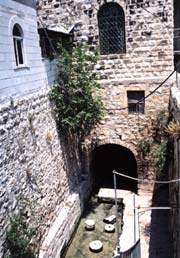Dating of King Hezekiah´s Tunnel Verified by Scientists

Siloam pool and the opening to the Siloam tunnel <br>Photo by courtesy of the Israel Nature and Parks Authority
Modern radiometric dating of the Siloam Tunnel in Jerusalem shows that it was excavated about 700 years before the Common Era, and can thus be safely attributed to the Judean King Hezekiah. This is the first time that a structure mentioned in the Bible (Kings II 20:20; Chronicles II 32:3, 4) has been radiometrically dated.
A report on the study of the Siloam Tunnel will be published on Sept. 11 in the scientific journal Nature. The research was conducted by Dr. Amos Frumkin of the Geography Department at the Hebrew University of Jerusalem, Dr. Aryeh Shimron of the Israel Geological Survey, and Dr. Jeff Rosenbaum of Reading University in England.
Radiometric dating is based on the decay of radioactive elements. These act as physical clocks, allowing researchers to estimate the age of the material being examined. In this case, the scientists used measurements of carbon-14 for dating organic material within the plaster of the Siloam Tunnel, as well as uranium-thorium for dating stalactites which grew in the tunnel since its construction.
Dating specific Biblical structures is extremely difficult because of poor archaeological preservation, identification uncertainty, scarcity of datable materials, and restricted scientific access into well-identified worship sites.
The presumption that King Hezekiah constructed the Siloam Tunnel was based until today upon the Biblical text itself and the characteristics of the Siloam inscription (located in a museum in Istanbul), although the inscription does not say who constructed the tunnel. The new findings refute a recent claim that suggested a much later date for the tunnel. The complicated tunneling project initiated by King Hezekiah brought water into the city of Jerusalem, protecting this valuable resource during the siege in 701 B.C.E. by the Assyrians, under their King Sancherib.
The half-kilometer long tunnel was constructed without using intermediate shafts, an engineering innovation for its day. A simpler method, used for thousands of years, was based on excavating vertical shafts from the surface. Short, horizontal tunnels were then cut from the shafts’ bottoms, and then easily connected to each other. The Siloam Tunnel is one of the oldest structures in use up to the present day.
Media Contact
More Information:
http://www.huji.ac.ilAll latest news from the category: Earth Sciences
Earth Sciences (also referred to as Geosciences), which deals with basic issues surrounding our planet, plays a vital role in the area of energy and raw materials supply.
Earth Sciences comprises subjects such as geology, geography, geological informatics, paleontology, mineralogy, petrography, crystallography, geophysics, geodesy, glaciology, cartography, photogrammetry, meteorology and seismology, early-warning systems, earthquake research and polar research.
Newest articles

First-of-its-kind study uses remote sensing to monitor plastic debris in rivers and lakes
Remote sensing creates a cost-effective solution to monitoring plastic pollution. A first-of-its-kind study from researchers at the University of Minnesota Twin Cities shows how remote sensing can help monitor and…

Laser-based artificial neuron mimics nerve cell functions at lightning speed
With a processing speed a billion times faster than nature, chip-based laser neuron could help advance AI tasks such as pattern recognition and sequence prediction. Researchers have developed a laser-based…

Optimising the processing of plastic waste
Just one look in the yellow bin reveals a colourful jumble of different types of plastic. However, the purer and more uniform plastic waste is, the easier it is to…



